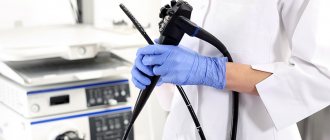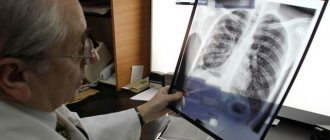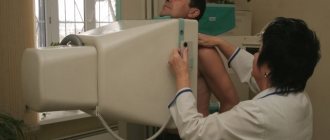Alternative diagnostic methods
Colonoscopy is considered the most informative method of examining the entire colon for the presence of neoplasms or various painful lesions in the intestine. However, a number of contraindications to this diagnostic procedure, as well as the possible categorical reluctance of the patient to perform such a diagnosis, lead to the need to search for alternative methods for examining the colon and the condition of its mucous membrane.
One of these alternative methods for diagnosing the intestines is sigmoidoscopy. However, it is worth considering that with sigmoidoscopy it is possible to examine the entire rectum and only 30 cm of the colon.
Colonoscopy with intravenous anesthesia
Videocolonoscopy under anesthesia (medicated sleep, general anesthesia) has a number of advantages:
- Since the pain syndrome is eliminated, we can guarantee with a 99% probability that we will examine the entire intestine, despite possible elongation of some parts of the intestine, kinks, and transversoptosis. The endoscopist performs the most detailed and complete examination;
- The doctor can safely perform an intestinal biopsy - tissue of the esophagus, stomach or intestines is taken from the affected area for laboratory tests;
- For the patient, the examination is painless, without discomfort and without any stress, which are inevitable with the classical method of performing the procedure.
Many patients are afraid of anesthesia, but it should not be compared with anesthesia for major operations, where there is always a certain risk. Unlike deep intubation anesthesia, where breathing is supported by a ventilator, with intravenous anesthesia with the drug propofol the patient breathes independently, the state is similar to deep sleep. Our clinic uses the highest quality and gentle anesthesia, which has a short-term effect, minimal toxicity, after waking up, patients feel rested, and sometimes with a feeling of slight intoxication, which quickly passes. Nausea, vomiting, and dizziness are completely absent, the patient comes to his senses within 5-10 minutes. after the procedure is completed.
We have performed a total of about 5,000 thousand colonoscopies with intravenous anesthesia, and we are convinced of their safety. At the same time, we are aware of the responsibility entrusted to us, and, in case of problems, we are ready to provide the entire list of necessary emergency assistance - we have a modern defibrillator - a Philips monitor that has passed licensing and metrological verification, an electrocardiograph, a pulse oximeter, an oxygen concentrator, stock of all possible medications for intensive care and emergency care.
Many patients worry about the increased risk of intestinal perforation during anesthesia, since the doctor does not see the patient's pain response. This is completely unfounded - when performing an endoscope, the doctor focuses on the sensation of resistance to the advancement of the endoscope, and not the pain syndrome; in addition, sudden movements of the patient due to pain during the procedure without anesthesia are the most dangerous.
During the examination, a video recording is made, which can be transferred to digital media. The recording is saved in the archive. The patient is given a conclusion and photographs
Description of the sigmoidoscopy procedure
Sigmoidoscopy is a diagnostic procedure designed to evaluate the condition of the rectum and part and lower part of the colon using a rectoscope.
A proctoscope is a special diagnostic device related to endoscopic equipment, the metal tip of which is inserted into the patient’s anus and allows you to examine the condition of the rectum and some parts of the colon at a distance of up to 30 cm from the entrance to the anus. Sigmoidoscopy, like colonoscopy, allows, during an examination of the intestine, to take biopsy material from a suspicious area for further examination.
Endoscopy: colonoscopy
Colonoscopy is a diagnostic medical procedure during which an endoscopist examines and evaluates the condition of the inner surface of the colon using a special probe.
Technically, colonoscopy is carried out by introducing an endoscope through the anus and sequential examination of the colon up to its proximal part. In this case, a prerequisite is the complete cleansing of the organ from its natural contents, which makes it possible to assess in detail the condition of the mucous membrane and topography of the colon and identify possible pathological changes. In addition, high-quality cleaning allows you to reduce the duration of the procedure and minimize those unpleasant subjective sensations that the patient may experience for various reasons.
Preparing the colon for endoscopy comes down to procedures aimed at freeing the organ from feces. In this case, the main conditions are the high probability and guarantee of a successful result, subject to standard preparation conditions, the simplicity and “manufacturability” of the method, the absence of side effects and, finally, the psychological attitude of the patient to carry out this type of preparation. An important aspect is the opportunity for independent training, including outside the walls of a medical institution. Today in practice there are two main methods of preparing the intestines for colonoscopy and operations: cleansing with laxatives and enemas and the lavage method. Taking into account all factors, including the likelihood of high-quality cleaning, “physiological”, the absence of side effects and contraindications, preference is given to the lavage method all over the world.
In practice, macrogol is most often used as a lavage cleansing agent, which is an osmotic laxative that is not absorbed or metabolized by intestinal flora.
Macrogol retains water in the lumen, resulting in mechanical leaching of the contents of the colon. In Russia today there is only one drug based on macrogol - Fortrans, which can be called a symbol of the modern method of preparing the colon for various manipulations, including colonoscopy. In addition to macrogol, it contains salt additives, which allows you to maintain the body’s water and electrolyte balance unchanged. The drug is biologically neutral and, unlike other laxatives, does not cause a possible exacerbation of existing intestinal diseases. In addition, it does not cause damage to the glycocalyx and the natural microbial landscape of the intestine is preserved.
The preparation method using Fortrans is quite simple. Each of the 4 sachets is dissolved in 1 liter of water, and the solution is drunk in equal portions over 4 hours. The taste of Fortrans is neutral - sweetish, not everyone likes it, but by the second liter the patient gets used to the taste and drinks the remaining 2 liters calmly. If the study is planned to be carried out in the afternoon, split use of the drug is possible - two liters the day before the study and two liters - in the morning on the day of the study. The laxative effect of Fortrans begins after 40–50 minutes. after the start of administration and usually ends 1–2 hours after its end. Optimal success in preparation, especially in patients prone to constipation, can be achieved by recommending a diet without waste during the previous 2 days.
Thus, the lavage method of colon cleansing using Fortrans is the most effective “physiological”, comfortable and safe method of preparing the colon for colonoscopy and operations.
What difficulties arise when preparing with Fortrans?
Preparing a patient for colonoscopy using Fortrans takes relatively little time and does not require the participation of medical personnel. In addition, since Fortrans is packaged in small bags, and the powder is dissolved immediately before use, it has become possible to significantly reduce the space required for its storage.
You should also keep in mind the easy and quick preparation of the Fortrans solution: the powder contained in small bags dissolves almost immediately in water. Preparation can be carried out in a comfortable environment and this will help the patient to participate more willingly in the examination process. Lavage with Fortransom does not require hospitalization for a colonoscopy, special diet, gastric catheter or enema.
How Fortrans works in a standard situation: after the first 1.5–2 liters of water are taken, it begins to act, and here it is necessary that the patient be near the toilet. Its effect continues throughout the subsequent intake and for another 1.5–2 hours after taking this liquid is completed.
Does Fortrans work the same in all patients? Maybe Fortrans does not completely cleanse the intestines of some people, do they need to follow some kind of diet or do enemas?
There are patients whose bowels are weaker, less functional, and take longer to have bowel movements. Here we would like to emphasize this nuance: despite the fact that the method is universal for 70% of patients, there remains 30% for which some preliminary preparation is required. For 2-3 days, we would recommend such patients not to eat food rich in toxins, and to take a more restrained approach to its quality and properties.
The greatest difficulties are associated with the volume of liquid drunk - not everyone can take 4 liters within 4 hours. Then one of the preparation options can be considered a fractional dose, when equal portions of the solution are spaced out over time.
The main differences in performing colonoscopy and sigmoidoscopy
The main difference between these two procedures for the patient is that sigmoidoscopy is less painful, takes less time and does not require long and serious preparation. All that is required of the patient before undergoing sigmoidoscopy is to avoid eating waste foods 3 days before the study, and the day before, thoroughly cleanse the intestines with an enema.
Sigmoidoscopy is performed without anesthesia, while during colonoscopy you can use medicated sleep. The proctoscope is inserted into the rectum a short distance, and the colonoscope, through the rectum, is inserted further along the colon, straightening its lumens with air pressure, which creates a certain discomfort and unpleasant sensations in the patient’s abdomen.
There are no absolute contraindications to sigmoidoscopy; there are only relative ones that prevent this diagnostic examination from being carried out only in acute cases. Relative contraindications for the sigmoidoscopy procedure include:
- presence of anal fissure;
- acute inflammation of the tissues surrounding the rectum
- intestinal bleeding;
- the impossibility of its implementation due to pathological narrowing of the lumen of the rectum.
After carrying out therapeutic measures to eliminate these contraindications, or when their symptoms subside, the sigmoidoscopy procedure can be performed.
Sigmoidoscopy method
The procedure itself in Moscow at the ProfMedPomosh clinic is not complicated. You need to lie on the couch on your side. First, a digital examination of the rectum is performed. Men undergo a thorough examination of the prostate to confirm or deny the presence of cancer.
The sigmoidoscope is inserted into the anal canal and slowly passed 30-60 cm into the intestine. If small polyps are found in this area, it is necessary to perform a biopsy of the formations. The doctor examines the mucous walls of the intestines. The whole procedure lasts about a quarter of an hour, according to reviews.
The patient may experience slight discomfort during the rectosigmoidoscopy procedure. Minor bleeding may occur after the procedure.
According to statistics, sigmoidoscopy reveals almost 90% of all disorders occurring in the colon and sigmoid colon.
Disadvantages of sigmoidoscopy
Why, with all its advantages, has this method not become dominant in diagnostics? Experts say that sigmoidoscopy cannot be a complete alternative to colonoscopy, since it does not provide complete data on the condition of the entire colon.
Sigmoidoscopy, as a method of diagnostic examination, is effective if there are the following indications for its implementation:
- establishing the cause of bleeding from the rectum - it could be anal fissures, polyps, hemorrhoids and even advanced stages of cancer;
- the presence of purulent or mucopurulent discharge from the anus, which may indicate the presence of inflammation of nearby tissues (paraproctitis);
- pain in the rectum during defecation, after it, and at any time, which may indicate not only the presence of internal hemorrhoids or fissures, but also the development of intestinal cancer.
So, sigmoidoscopy is a good method for examining the lower parts of the colon. If it is necessary to examine the entire colon with a detailed study of the mucous membrane, it is necessary to conduct a total colonoscopy, that is, an examination throughout the entire colon. Therefore, in combination with sigmoidoscopy, additional studies of the condition of the large intestine may be prescribed, such as
- virtual colonoscopy, in which the examination is performed using a high-precision computed tomograph;
- Ultrasound of the large intestine, if the clinic has new generation ultrasound equipment;
- radiography using a barium mixture, in which a contrast agent is introduced into the cavity of the colon, allowing one to examine its walls and identify the presence of a defect on it.
Such examinations, together with sigmoidoscopy, are not cheap, and they also take time. Moreover, all of the above studies do not provide such a high percentage of information as colonoscopy and do not resolve the issue of collecting biopsy material from the inner mucous membrane of the large intestine.
Conclusion. In some cases, it is impossible to make an accurate diagnosis to determine effective treatment for colon diseases without a colonoscopy. Therefore, if the patient’s fear and fear are the only contraindications to conducting this highly accurate study, we suggest undergoing the study under anesthesia, or rather in a state of medicated sleep. In this case, you will avoid any possible feelings of discomfort.
Find out the cost of the Videocolonoscopy procedure
Preparing for research
Preparation for sigmoidoscopy is no different from preparation for colonoscopy. To examine the mucous membrane of the colon, before both procedures, you need to perform a special cleansing of the intestines and introduce temporary dietary restrictions: before starting the manipulation, you need to exclude vegetables, roughage and fruits from the diet for several days. Very often, proctologists advise sigmoidoscopy and colonoscopy to be performed on an empty stomach.
Preparation for colonoscopy and sigmoidoscopy includes:
- conducting cleansing enemas and microenemas (one enema is done on the evening before the diagnosis, the second on the day of the examination, several hours before the start of the manipulation);
- taking medications with a laxative effect.
Some patients who experience frequent constipation may combine laxative medications and cleansing enemas.
Vinikli nutrition - consult a doctor
To make an appointment for a consultation, call or fill out the return form:
(050) 301-99-26 (067) 446-11-79
Damn,
Your request has been successfully sent!
A call center specialist will contact you as soon as possible to clarify all the details.
Preparation before sigmoidoscopy and colonoscopy should be especially thorough, as it affects the accuracy of the diagnostic results. The proportion of patients with poor bowel preparation is very high and, according to various sources, reaches 20-40%. This is stated in the monograph “Effective bowel preparation for colonoscopy,” published under the leadership of E.B. Avalueva, S.I. Sitkina, B.Kh. Samedova, E.I. Tkachenko and others.
Equipment
Dear patients! We inform you about equipment updates! FUJINON EPX-4450 HD is the latest electronic video endoscopic system from FUJIFILM, which today is the company’s flagship and is used in leading endoscopic expert centers in MOSCOW, Kyiv, ROSTOV.
New thin video gastroscope - Fujifilm EG-530WR - 9.3 mm, versus 9.8 - 11.5 mm, in standard (modern) endoscopes.
New thin video colonoscope - EC-450LP5 for more comfortable procedures without sedation.
New video colonoscope - FUJINON EC-590 WI with SuperCCD matrix

- We attach fundamental importance to the level of equipment. YOU SHOULD ONLY WORK ON MODERN PROCESSORS AND ENDOSCOPES, SINCE THE DIFFERENCE IN THE FREQUENCY OF NEOPLASIA DETECTION AND ASSESSMENT OF THE CONDITION OF THE MUCOSA COMPARED WITH EQUIPMENT OF PREVIOUS GENERATIONS IS COLOSSAL.
- FUJINON EPX-4450 HD is the FUJIFILM electronic video endoscopic system, which is currently the company’s flagship. The system is built on the basis of modern technologies and opens up new diagnostic capabilities, provides high clarity and extensive image processing capabilities.
- Colonoscope EC-590WL Endoscopes with SUPER CCD technology use a line-by-line scanning method that eliminates loss of resolution. This allows you to capture still images with high definition. Images have low chromatic noise and look very realistic even when frozen. The use of SUPER CCD technology allows not only to increase image resolution, but also to achieve, thanks to RGB filtering, accurate color rendition in the red part of the spectrum, which is very important for diagnostics. This endoscope is truly high quality, created in the era of digital imaging.
- The EC-450LP5 ultra-thin colonoscope is based on Fujinon's latest advances in insertion design. The colonoscope has the usual parameters of colonoscopes for adults, but the outer diameter of its inserted part is only 11.1 mm with a fairly large diameter of the instrumental channel (3.2 mm). The colonoscope is easy to manipulate and is ideal for examining children, small women and elderly patients.
- Processing is carried out in accordance with current sanitary regulations and meets high-level disinfection standards. Processing includes:
- Preliminary cleaning of the colonoscope - washing solution.
- Pre-sterilization cleaning enzyme solution – UMD enzyme.
- Sterilization, high-level disinfection – blanidaz active, blanidaz active enzyme.






